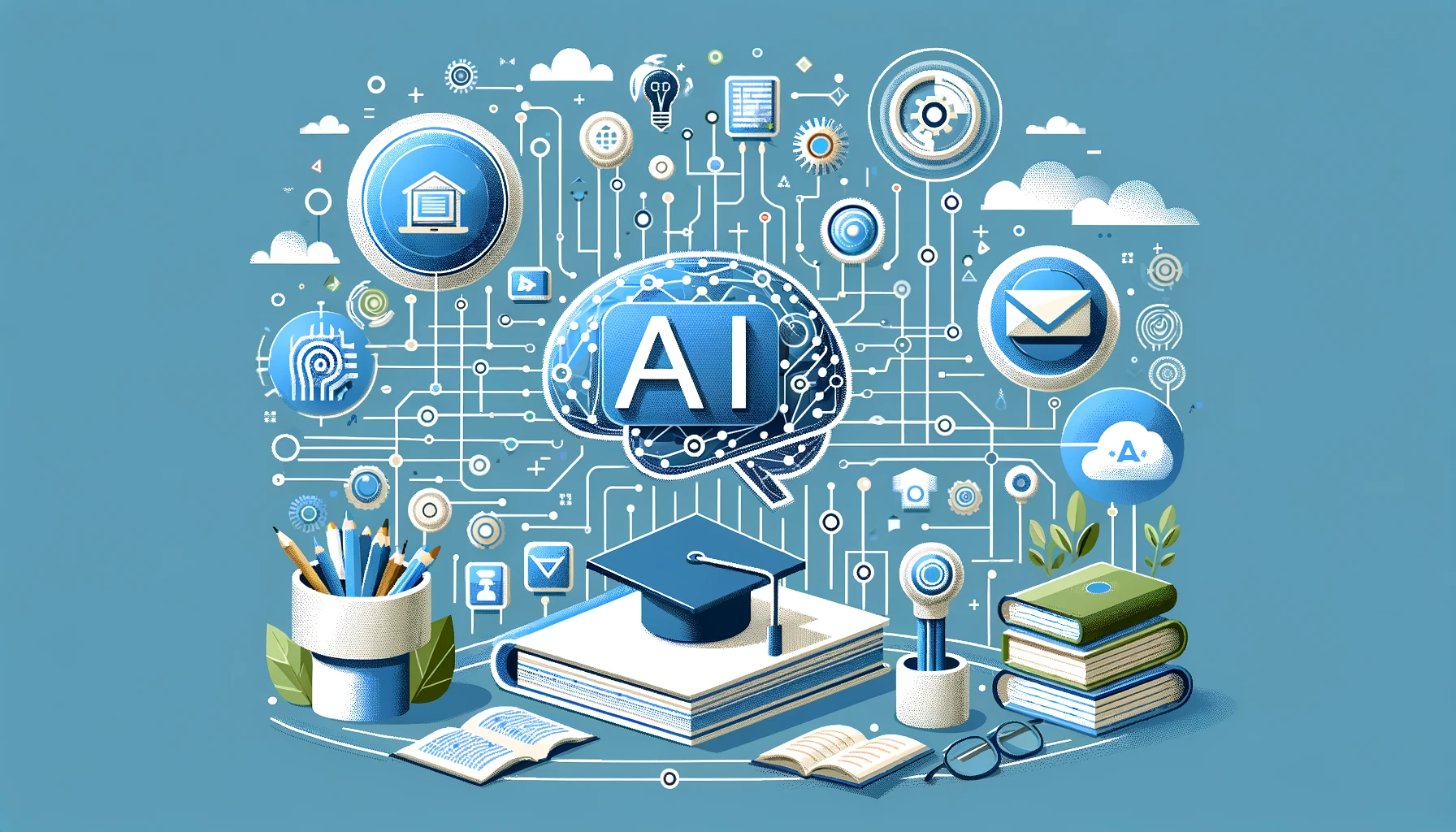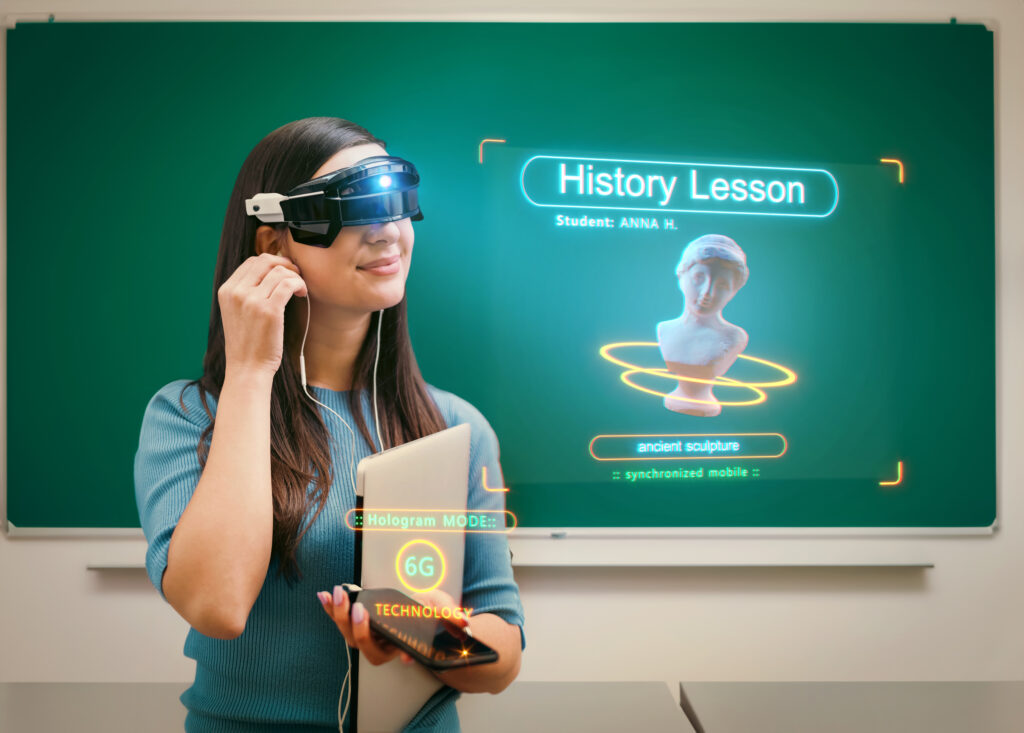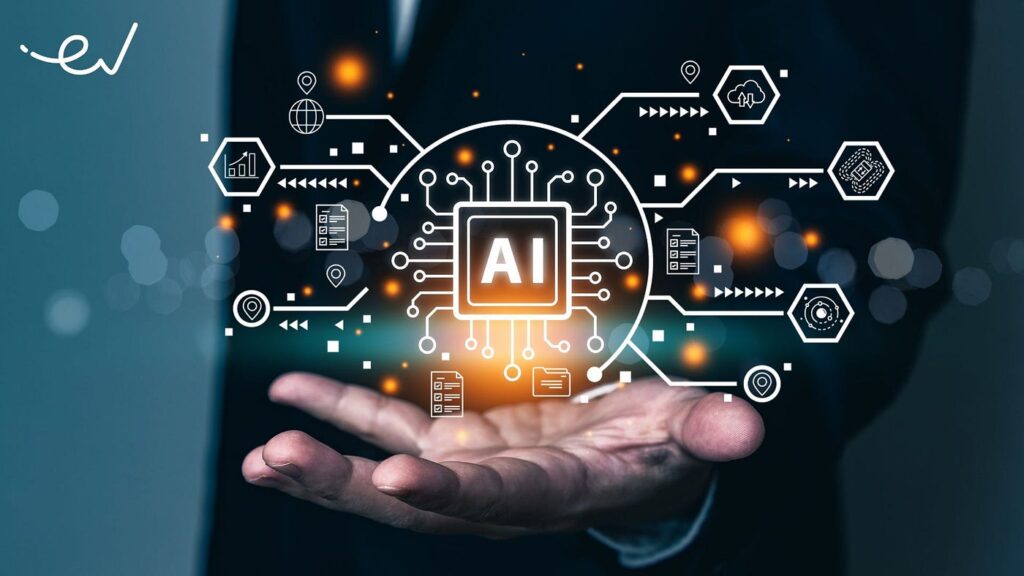
AI is revolutionizing education, transforming traditional classrooms into dynamic learning environments. By personalizing learning experiences, AI caters to individual student needs, replacing one-size-fits-all approaches with tailored solutions. Through adaptive assessments and instant feedback, students receive targeted support, fostering growth and understanding. AI streamlines administrative tasks, freeing up educators to focus on teaching and mentoring students.

Table of Contents
In contrast to outdated methods, AI offers real-time insights into student progress and comprehension levels, enabling timely interventions to enhance learning outcomes. With AI’s ability to analyze vast amounts of data quickly, educators can make informed decisions based on actionable intelligence. Embracing AI in education holds the promise of a more efficient, engaging, and effective learning experience for all stakeholders.
AI’s Transformative Role
Education Revolution
AI is reshaping education by transforming traditional methods and embracing technology-driven approaches. The potential of AI to revolutionize learning lies in its ability to personalize education for students. This shift towards technology-driven educational systems enhances accessibility and flexibility.
Enhanced Learning
AI enhances student learning by offering personalized experiences and real-time feedback. Examples of AI tools improving comprehension include adaptive learning platforms and intelligent tutoring systems. By making learning more engaging and effective, AI fosters a deeper understanding of complex concepts.
Teacher Support
AI supports teachers by streamlining lesson planning, providing data-driven insights for student assessment, and automating administrative tasks. The benefits of AI in reducing administrative burdens allow educators to focus more on teaching. AI tools also assist teachers in delivering personalized guidance tailored to individual student needs.
Global Impact
AI is influencing education globally, albeit with disparities in adoption rates across countries. Some regions embrace AI more readily than others due to varying infrastructural challenges. Success stories of AI implementation in diverse educational settings showcase the positive impact on student outcomes and overall educational quality.
Key Companies’ Initiatives
Tech Innovations
Artificial intelligence has revolutionized the education sector, introducing cutting-edge technological advancements. Innovations like personalized learning platforms and virtual tutors have reshaped traditional teaching methods. These tools cater to individual student needs, enhancing understanding and retention of academic concepts. The integration of AI in educational tools has significantly improved student engagement levels. By incorporating interactive elements and adaptive learning techniques, students are more motivated to participate actively in their learning journey.
AI-driven advancements have also played a vital role in boosting academic performance. Tools such as automated grading systems and intelligent tutoring systems provide instant feedback to students, enabling them to track their progress effectively. This real-time feedback mechanism helps students identify areas for improvement promptly, leading to enhanced academic outcomes. The use of AI algorithms in analyzing student data allows educators to tailor instructional strategies based on individual learning styles and preferences.
Partnership Models

Collaborative efforts between educational institutions and AI technology providers have paved the way for innovative solutions in the education sector. Partnership models focus on leveraging each other’s strengths to create impactful educational experiences. Successful collaborations have resulted in the development of AI-powered tools that cater to diverse learning needs. By combining expertise from both sectors, these partnerships drive the seamless integration of AI technologies into educational settings.
Strategic alliances between schools/universities and AI companies bring forth a myriad of benefits. Partnerships facilitate access to state-of-the-art technologies and resources, enabling educational institutions to stay at the forefront of innovation. Moreover, collaborative initiatives foster knowledge sharing and best practices exchange, promoting continuous improvement in teaching methodologies. By working together, institutions can harness the full potential of AI in optimizing learning outcomes for students across various disciplines.
Success Stories
AI’s transformative impact on education is evident through inspiring success stories that showcase its positive outcomes. Real-world examples highlight how AI initiatives have led to significant improvements in educational outcomes for learners. For instance, adaptive learning platforms powered by AI algorithms have helped students achieve higher proficiency levels in subjects like mathematics and science. These platforms personalize learning experiences based on individual progress, resulting in enhanced comprehension and retention rates.
Case studies of successful AI implementations underscore the effectiveness of technology in educational settings. By analyzing data patterns and identifying trends, AI systems assist educators in creating tailored lesson plans that cater to diverse student needs effectively. Such personalized approaches not only boost academic performance but also foster a supportive learning environment conducive to student growth and development.
AI’s Educational Applications
Personalized Learning
AI revolutionizes education through personalized learning methods, catering to individual student needs effectively. By leveraging AI technologies, educational content can be tailored to suit each student’s unique learning style and pace. This personalized approach enhances student engagement and comprehension, ultimately leading to improved academic performance.
- Benefits of Personalized Learning:
- Enhances student outcomes by addressing specific learning needs.
- Boosts student motivation and confidence in their abilities.
- Facilitates self-paced learning, allowing students to progress at their own speed.
Automated Grading
AI plays a crucial role in streamlining the grading process for educators by automating grading tasks efficiently. Through AI-powered systems, educators can save time on manual grading processes while ensuring accuracy in assessing student work. Automated grading also provides timely feedback to students, enabling them to track their progress and make necessary improvements promptly.
- Efficiency Gains of Automated Grading:
- Reduces the burden on educators by automating repetitive grading tasks.
- Improves grading accuracy by eliminating human errors in assessment.
- Enables educators to focus more on providing targeted support to students.
Interactive Tools
Innovative interactive AI tools are transforming traditional classrooms into engaging environments that foster active participation among students. These tools leverage AI algorithms to create immersive learning experiences that promote collaboration and critical thinking skills. By integrating interactive learning platforms into the curriculum, educators can enhance student motivation and drive curiosity in diverse subjects.
- Impact of Interactive Tools:
- Enhances student engagement through interactive and dynamic learning experiences.
- Fosters collaborative problem-solving skills among students.
- Encourages creativity and innovation through hands-on activities facilitated by AI-driven tools.
Overcoming Implementation Hurdles
Ethical Considerations
AI in education raises ethical concerns that need careful consideration to ensure responsible implementation. Transparency and accountability are crucial aspects when deploying AI algorithms in educational settings. It is essential to prioritize fairness and address biases that may inadvertently impact students’ learning experiences.
When integrating AI into education, it is vital to evaluate the implications of bias and work towards creating fair and inclusive AI-powered systems. By promoting transparency, educators can build trust with stakeholders and foster a culture of ethical AI use in schools. Ensuring that AI algorithms are designed with fairness in mind can lead to more equitable educational outcomes for all students.
Data Privacy
Maintaining data privacy is paramount in AI-driven educational platforms to safeguard sensitive student information. Implementing robust measures to secure and protect data is crucial for building trust with students, parents, and educators alike. Compliance with data protection regulations such as GDPR is necessary to uphold the confidentiality of student data.
Educators must prioritize the security and confidentiality of student data when utilizing AI technologies in classrooms. By implementing encryption protocols and access controls, schools can mitigate potential risks associated with data breaches. Upholding high standards of data privacy not only protects student information but also instills confidence in the use of AI tools for educational purposes.
Teacher Training
Comprehensive training programs are essential to equip educators with the necessary skills to leverage AI effectively in teaching practices. Providing teachers with AI training opportunities can enhance their ability to utilize technology for personalized learning experiences. Integrating AI training into teacher development programs presents both challenges and opportunities for enhancing classroom instruction.

The success of AI implementation in classrooms heavily relies on the proficiency of teachers in utilizing these technologies. Offering ongoing support and resources for professional development can empower educators to embrace AI tools confidently. Investing in teacher training not only enhances instructional practices but also paves the way for a more innovative and engaging learning environment.
Addressing Skepticism
Myth Busting
AI in education often faces skepticism due to prevalent myths and misconceptions. One common myth is that AI will replace teachers, but in reality, it complements traditional teaching methods. Critics often believe that AI hinders student-teacher interactions; however, studies show that AI can actually enhance personalized learning experiences.
Contrary to popular belief, AI does not dehumanize the learning process. Instead, it empowers educators by providing valuable insights into student progress and areas needing improvement. By leveraging AI tools, teachers can tailor their teaching strategies to meet individual student needs effectively.
Real Benefits
The benefits of integrating AI in education are substantial and tangible. One key benefit is how AI can identify and bridge learning gaps among students. Through data analysis, AI algorithms pinpoint areas where students struggle, enabling educators to intervene promptly and provide targeted support.
Moreover, AI enhances student performance by offering personalized learning experiences. Adaptive learning platforms powered by AI adjust content delivery based on individual student progress and learning styles. This personalized approach fosters better engagement and understanding among students.
In real-world scenarios, schools have witnessed significant improvements in academic outcomes after implementing AI technologies. For instance, a school district integrated an AI-powered tutoring system that resulted in a notable increase in math scores among students. The system identified areas of weakness for each student and provided tailored exercises to strengthen their skills.
Classroom Transformation
Beyond Traditional Methods
AI is revolutionizing education by pushing boundaries beyond traditional teaching methods. Through personalized learning algorithms, AI caters to individual student needs efficiently. The integration of AI in education transforms the way students engage with content and assessments.
The transformative potential of AI lies in its ability to create innovative learning experiences. By analyzing data on student performance, AI can provide real-time feedback and personalized recommendations. This adaptive approach enhances student understanding and retention rates significantly.
AI drives a shift towards adaptive and dynamic educational approaches that cater to diverse learning styles. By leveraging machine learning algorithms, educators can customize lesson plans and resources for each student. This tailored approach fosters a deeper understanding of concepts and promotes critical thinking skills.
Future Classrooms
Imagine futuristic classrooms powered by AI technologies where learning is personalized for every student. These classrooms will feature interactive tools and virtual reality simulations to enhance engagement and comprehension. AI integration will enable seamless communication between students and teachers, fostering collaboration and creativity.
The evolution of learning environments with AI integration will lead to more interactive and immersive experiences for students. Virtual tutors powered by AI will provide instant assistance, guiding students through complex problems and concepts. This hands-on approach accelerates learning outcomes and encourages independent thinking.
AI holds immense potential in shaping the future of education by streamlining administrative tasks for educators. From grading assignments to managing resources, AI automation frees up time for teachers to focus on impactful interactions with students. As AI continues to evolve, it will play a pivotal role in creating a more efficient and effective educational ecosystem.
Maximizing AI Benefits
Correct Implementation
Implementing AI in education requires careful planning and execution to maximize its benefits. Schools should prioritize training teachers on using AI tools effectively. It is crucial to choose the right AI solutions tailored to specific educational needs.
To ensure successful implementation, schools must establish clear goals for integrating AI technologies in classrooms. Developing a robust infrastructure to support AI applications is essential for seamless operation. Regular maintenance and updates of AI systems are necessary for optimal performance.
Challenges in deploying AI solutions can be overcome by fostering a culture of open communication and collaboration among educators, students, and tech experts. Providing adequate technical support and resources is vital for addressing any issues that may arise during implementation.

Key considerations for effective integration include ensuring data privacy and security measures are in place to protect sensitive information. Collaborating with AI developers to customize solutions according to educational objectives enhances the overall learning experience.
Continuous Evaluation
Continuous evaluation of AI tools is imperative to gauge their impact on student learning outcomes. Schools should regularly assess how AI interventions contribute to enhancing student engagement and academic performance. Utilizing data analytics helps in measuring the effectiveness of AI-driven strategies.
Methods for assessing impact involve collecting feedback from teachers, students, and parents to understand the user experience with AI technologies. Conducting periodic assessments and surveys enables schools to identify areas where AI can further improve educational processes.
Feedback loops play a crucial role in refining AI-driven educational strategies based on real-time insights gathered from classroom interactions. Implementing changes based on feedback ensures that AI tools evolve to meet the changing needs of students and educators.
Challenges and Solutions
Technological Barriers
AI implementation in education faces technological challenges such as outdated infrastructure and limited connectivity. These obstacles hinder the integration of AI tools into educational settings. Without proper infrastructure, schools struggle to leverage the benefits of AI technology effectively.
To address knowledge gaps in AI adoption, schools must invest in upgrading their technological infrastructure. This includes ensuring high-speed internet access and adequate hardware to support AI applications. By improving these aspects, educational institutions can create a conducive environment for implementing AI solutions.
Moreover, access to AI tools remains a significant issue, especially for schools in remote or underserved areas. Limited access to advanced technologies hinders students’ exposure to AI-driven learning experiences. To bridge this gap, policymakers and educators must prioritize providing equal access to AI resources for all students.
One solution is to establish partnerships with tech companies to provide schools with AI tools and training programs. These collaborations can help schools overcome financial constraints and technical limitations when integrating AI into their curriculum. By fostering these partnerships, schools can enhance students’ learning experiences through innovative AI applications.
Accessibility Issues
Ensuring equitable access to AI-powered education is crucial for promoting inclusive learning environments. Students from diverse backgrounds should have equal opportunities to benefit from AI tools in their academic pursuits. Addressing accessibility concerns is essential for leveling the playing field in education.
Accessibility issues in AI education can impact learning outcomes significantly. Students who lack access to necessary resources may fall behind their peers who have access to AI technologies. This disparity can widen existing achievement gaps and perpetuate inequalities in educational attainment.
One strategy to promote accessibility is by incorporating universal design principles into AI tools and platforms used in education. Designing user-friendly interfaces that cater to diverse learning needs can enhance the usability of AI applications for all students. By prioritizing accessibility features, educators can ensure that no student is left behind in benefiting from AI advancements.
Global Educational Trends
Adoption Rates
AI adoption rates in educational institutions are steadily increasing, with more schools integrating AI tools and technologies into their systems. This integration is driven by the desire to enhance teaching methods and provide personalized learning experiences for students. Factors such as budget constraints, technological infrastructure, and teacher training influence the speed and extent of AI adoption in schools. Schools with ample resources tend to adopt AI more rapidly, leading to disparities in access to advanced educational technologies among students. These varying adoption rates have significant implications on student learning experiences, shaping how students interact with educational content and receive support from AI-powered tools.
Policy Development
The growing presence of AI in education highlights the urgent need for robust policy frameworks that govern its ethical use. Policymakers play a crucial role in ensuring that AI implementation in schools aligns with ethical standards and safeguards student data privacy. Collaboration between policymakers, educators, and technology experts is essential in developing policies that address potential risks associated with AI integration in education. By establishing clear guidelines and regulations, policymakers can promote responsible AI usage while fostering innovation in educational practices. The development of comprehensive policies can help mitigate concerns related to bias, data security, and transparency in AI-driven educational systems.
Summary
You’ve explored how AI is revolutionizing education, from enhancing personalized learning experiences to tackling implementation challenges. Key companies are driving innovation, and global trends reflect a shift towards AI integration. Embracing AI in education can lead to a more efficient and effective learning environment, preparing students for a tech-driven future.
To leverage AI’s full potential in education, stay informed about the latest advancements and best practices. Engage with educational AI tools and platforms, fostering a culture of continuous improvement. By embracing AI in education, you pave the way for a brighter, more adaptive learning landscape that equips students with essential skills for tomorrow’s world.
Related Article:
Featured Image courtesy of DALL-E by ChatGPT
